
Originally posted on https://www.thehoth.com/voice-search-seo/
Originally posted on YouTube by The HOTH
Voice search is on the rise.
That makes NOW a great time for you to learn all about it!
Is voice search SEO *really* that important?
Yes, it is. Just consider that:
- 1 in 2 smartphone users now use voice technology daily (Comscore)
- 50% of all searches will be voice by 2020 (Comscore)
- 72% of people who own a voice-activated speaker say their devices are often used as part of their daily routine (Think With Google)
Why is voice search growing so quickly? There’s a lot driving this trend!
- For one, people want to get quick answers without having to type (Stone Temple)
- And voice is faster than typing (Bruce Clay)
- Voice search is perfect for on-the-go mobile searches, and mobile use in general is up (Statista)
- Smart speakers and digital assistants are also being used more, and voice is the interface of those devices (NPR and Edison Research)
These trends together paint a picture of the future where we talk to our computers more than we type on them…if we even still type on them at all!
How can you adapt to the voice search revolution?
Read on: We’re about to tell you!
The Major Players: Google vs. Siri vs. Alexa
When you do a voice search on a mobile device, computer, or a smart speaker, it runs through a digital assistant.
The advice in this article applies to the two most widely-used digital assistants: Siri and Google Assistant:
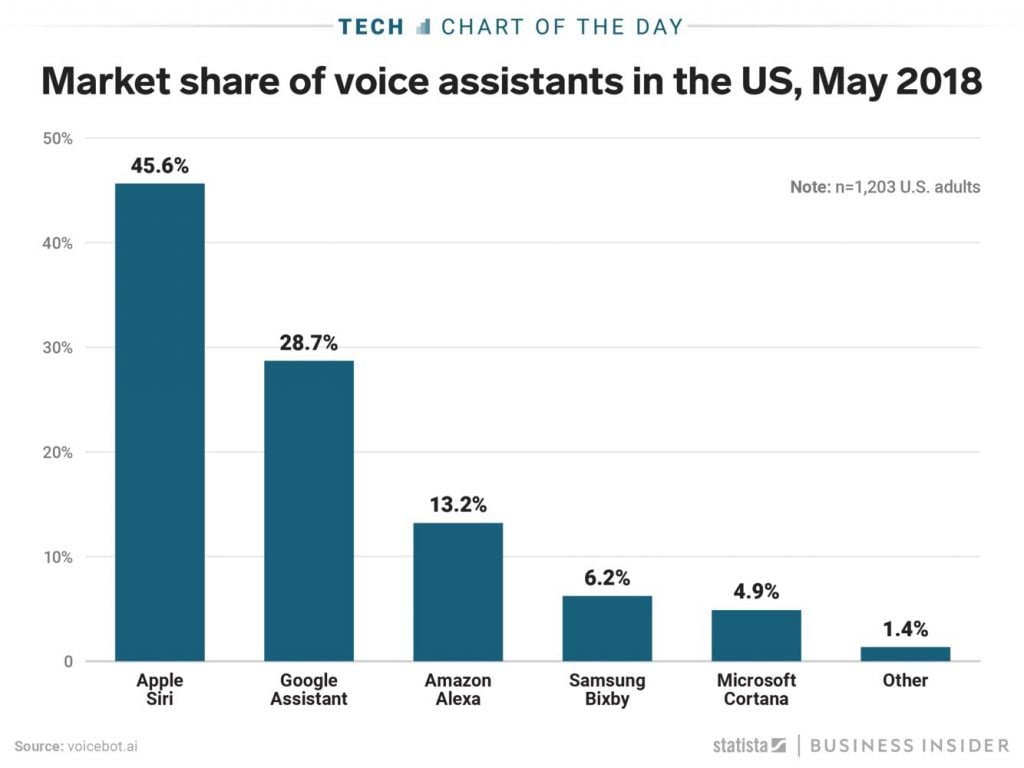
When you do a search with these two apps, they both pull their results from Google.
Bing was Siri’s source for results until Apple switched Siri to Google’s search in 2017.
By optimizing for Google voice, you’ll be optimized for Siri as well.
Amazon and Google are fierce competitors, and this is likely why Alexa uses Bing results. Though Alexa is a player on the voice search field, you’re better off optimizing for Google.
A sidenote: Google Assistant was found to be the most accurate digital assistant according to a report by Loup Ventures:
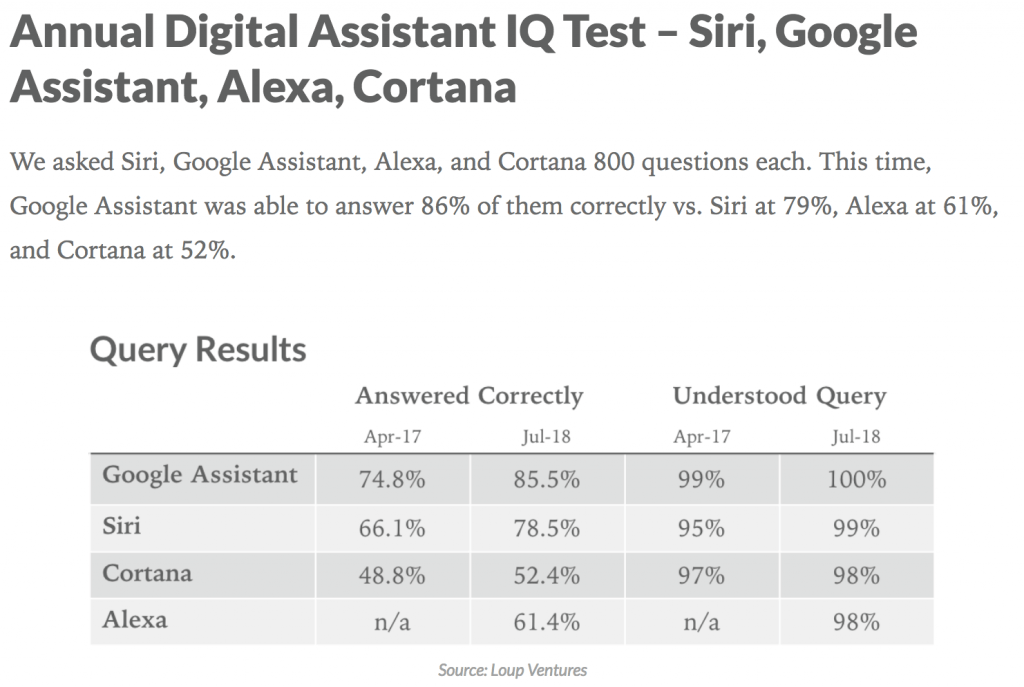
This is further confirmation that you’re better off optimizing for Google’s voice search function rather than a competitor.
Differences Between Voice Search vs. Typed Search
Search habits for voice queries are different than typed queries. Searching with voice changes how, when, and what people search for.
How We Search
The way we speak to digital assistants creates new voice search keywords that are more conversational than typed keywords.
This matters for voice search optimization because it affects what keywords you use and the on-page optimization you do with them.
You might normally type “pumpkin pie recipe,” but with a voice query you’d be more likely to say, “How do I make pumpkin pie?” There’s a different featured recipe result for each query:
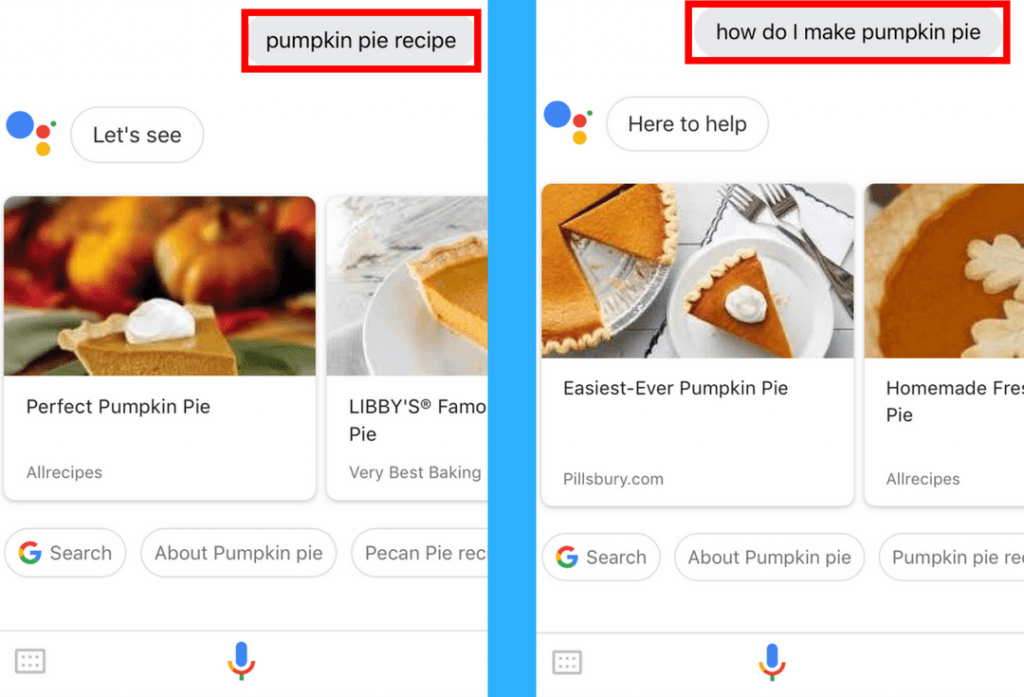
The way this works is related to Google’s Hummingbird update.
With Hummingbird, Google became an “answer engine.” Now you can get tons of relevant search results right in Google without clicking on a website.
Hummingbird emphasized semantic search (conversational keywords) and implied query meaning (the intent behind the search terms).
The way Hummingbird matches context and intent to the needs of the user is the foundation for voice search.
Google’s RankBrain language-learning A.I. picks up what people are really looking for when they search. Google’s Knowledge Graph shows them that result in an infobox:
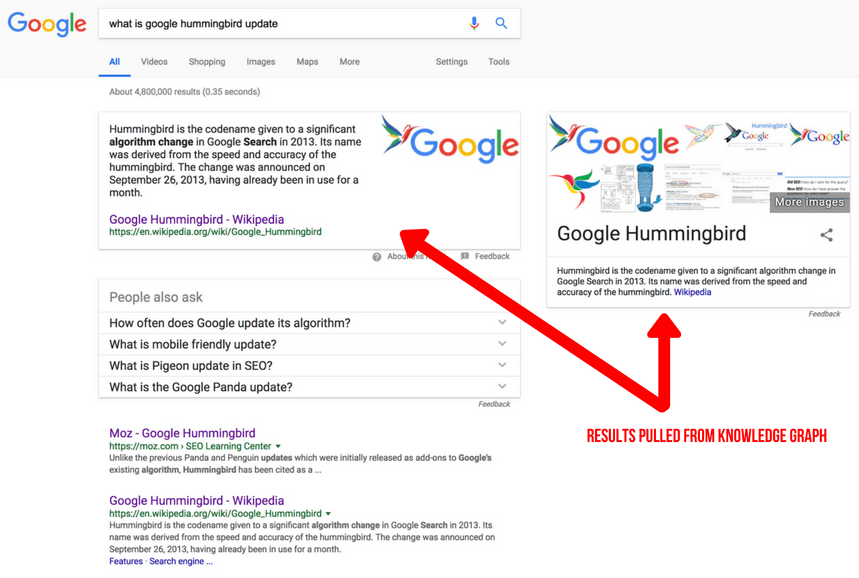
Google wants to know the user intent behind searches, but it’s hard for machines to recognize.
They divide intent into 4 main categories: informational, navigational, actional, transactional. Or: “I want to [know, go, do, or buy]”.

To demonstrate how this all works, you might do a search like: “Who is Ric Flair”
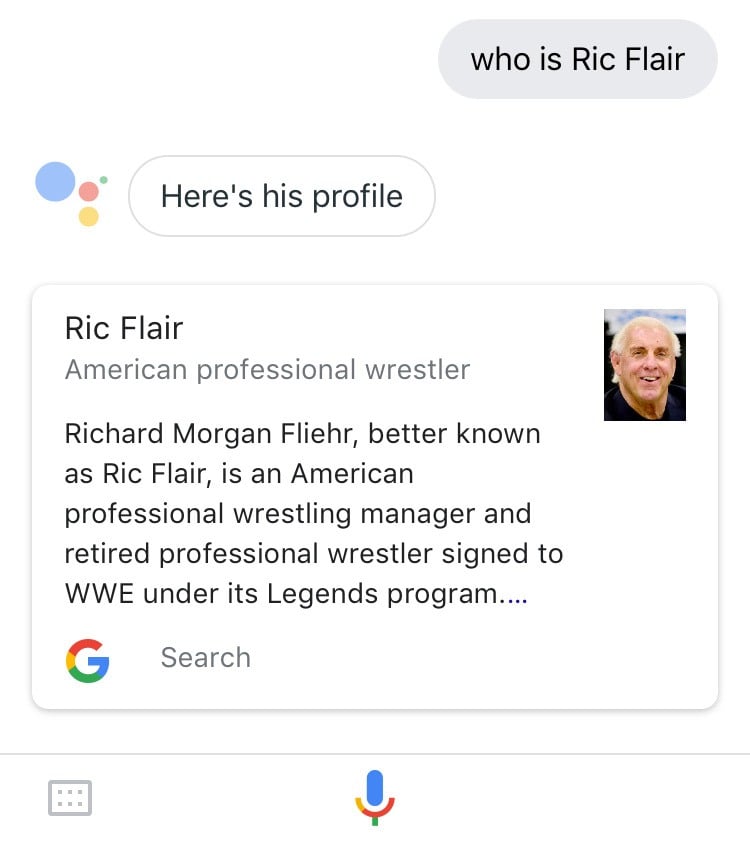
Now if I ask a follow-up question, “Where is [he] from?” Google will understand the implied meaning of “he” as Ric Flair:
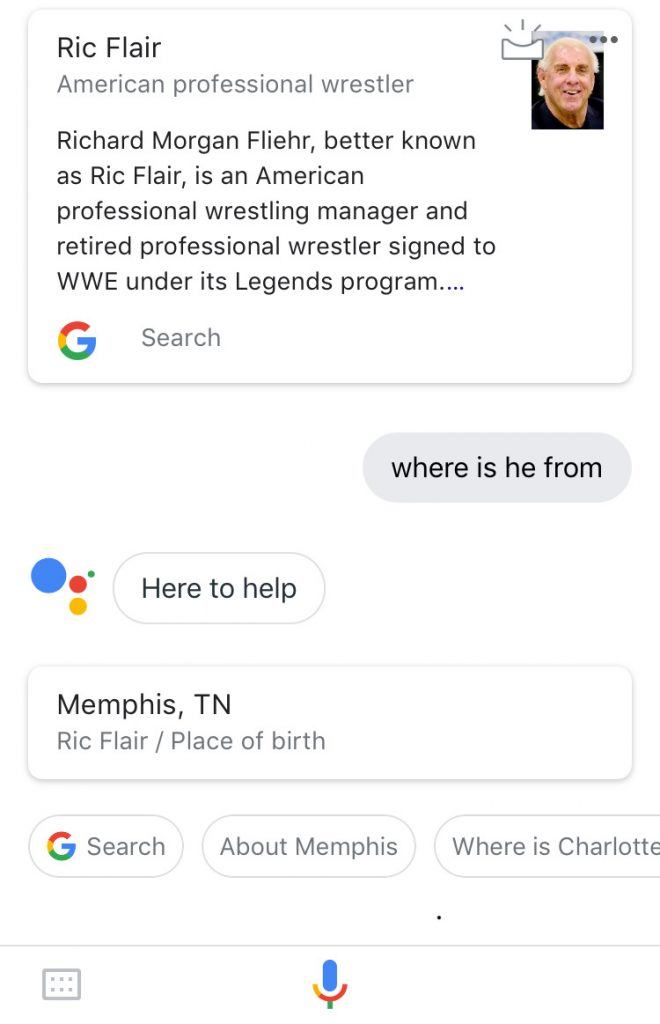
Because of my first search, Google knows who I’m talking about. Each question is relevant to the one before it, rather than each search being treated as a blank slate.
This is a more conversational and intuitive experience. And it’s why semantic search is central to voice search.
When We Search
People use voice search all the time: at home, in the office, and on-the-go.
This is mainly taking place on mobile devices, which makes sense as people are most likely to use voice search on their mobile device while driving.
The on-the-go usage of voice search is reflected by how “____ near me now” searches are up 150%.
Google uses their geolocation data to provide an answer to a “____ near me” search:
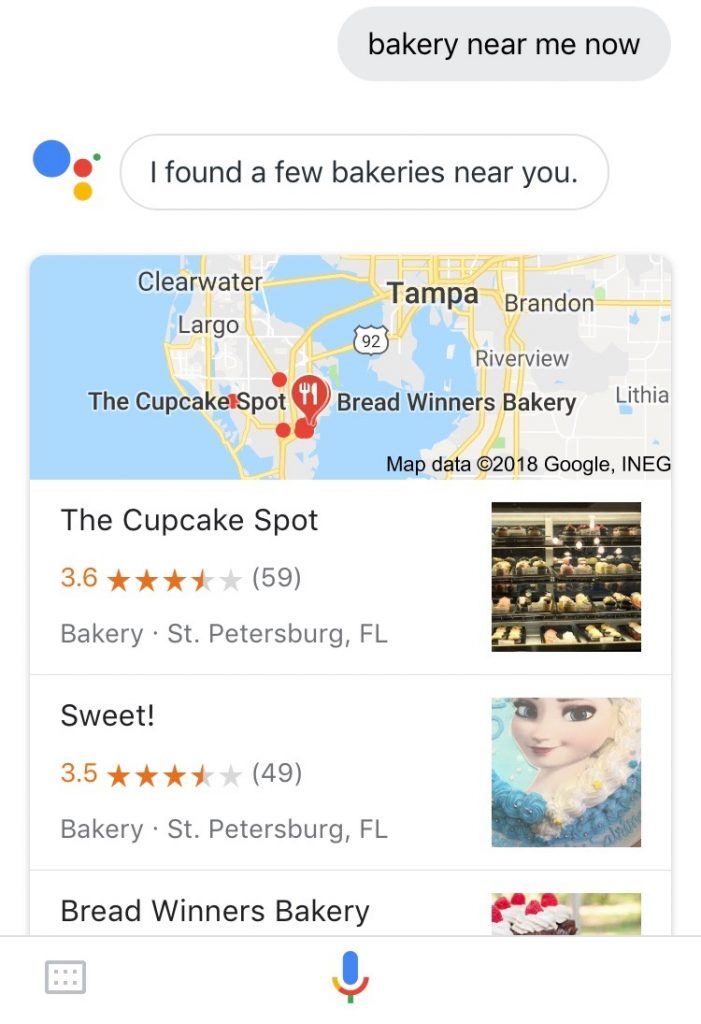
The same search with Siri will yield different results from Apple’s Maps app, which uses data from multiple companies including Yelp and Foursquare:
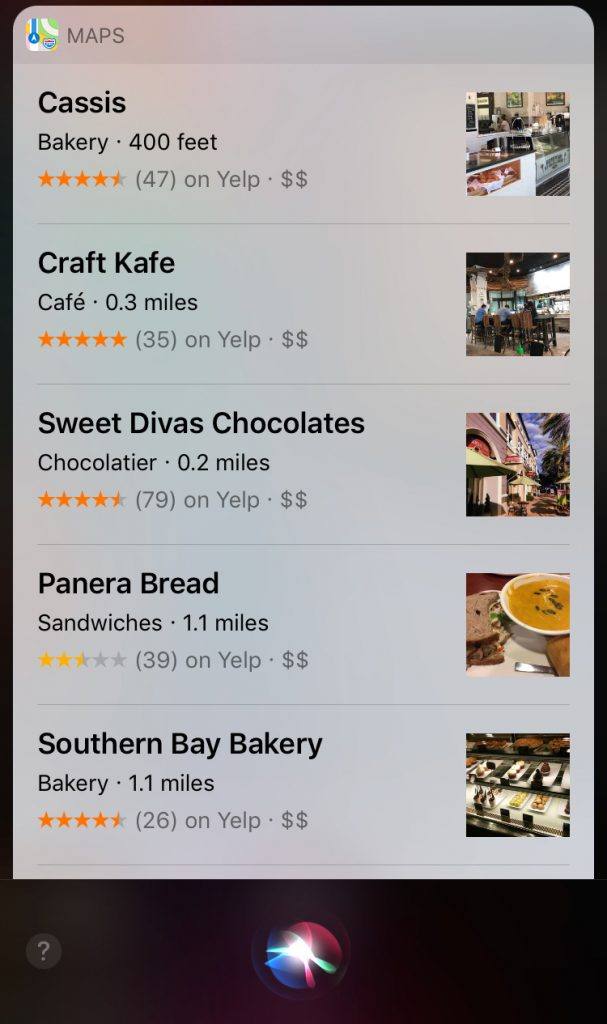
While Siri and Google use different geographic databases, when it comes to regular search results they both use Google.
Google will usually read the answer to you if it’s found in a featured snippet:
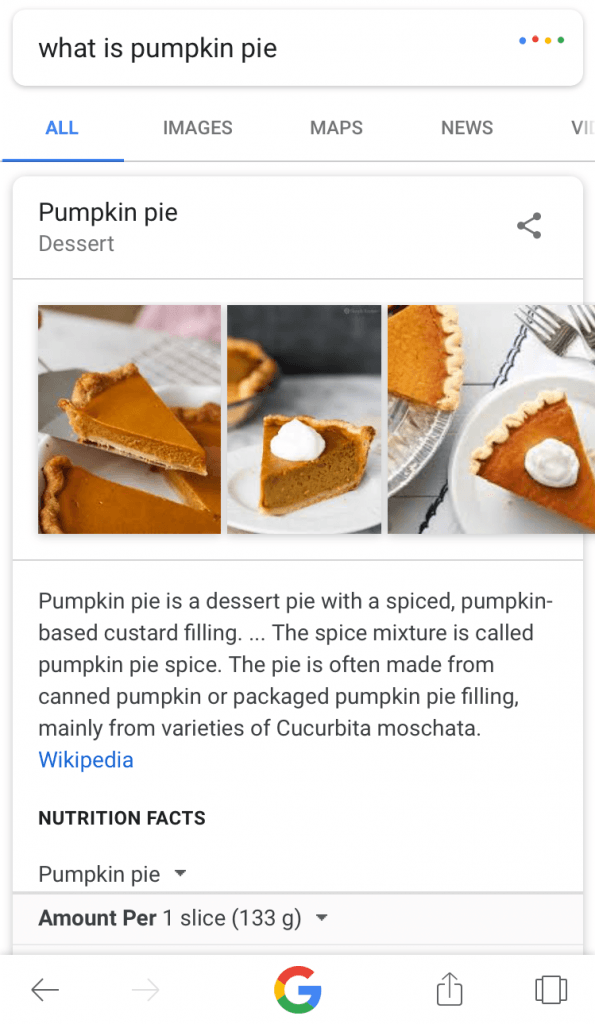
Siri doesn’t usually read the web result automatically like Google. Siri will read the result to you on request when you ask “can you read this to me” after performing a search:
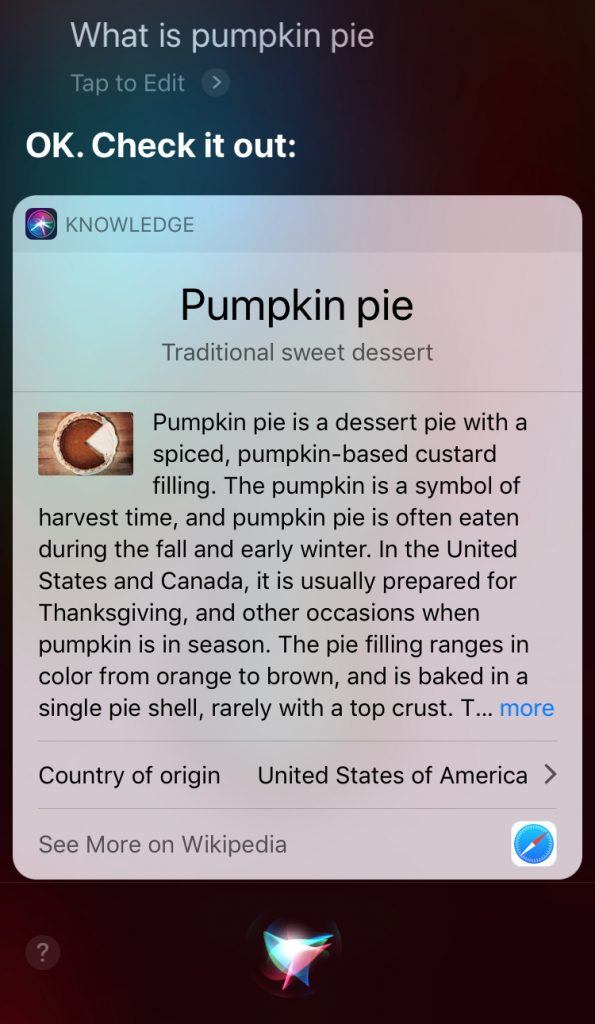
Unlike a navigational search with these assistants, the same featured result is usually shown in Siri and Google since they both use Google’s search engine database.
The bottom line here is that people use voice search when they want a quick answer. This is why content that’s optimized for voice needs to give people direct answers to their specific questions.
What We Search For
When it comes to voice search, people aren’t necessarily looking for instructions on complex tasks. Rather, they are usually looking for micro-data.
Google knows you’d rather get a quick direct answer in the results right now than take extra time to visit a site. That’s why they’re so focused on featuring that micro-data in search results.
For example: instead of searching for “most common dog breeds” and sifting through top 10 results, you’d use voice search to say “what are the most common dog breeds” and get one result right away.
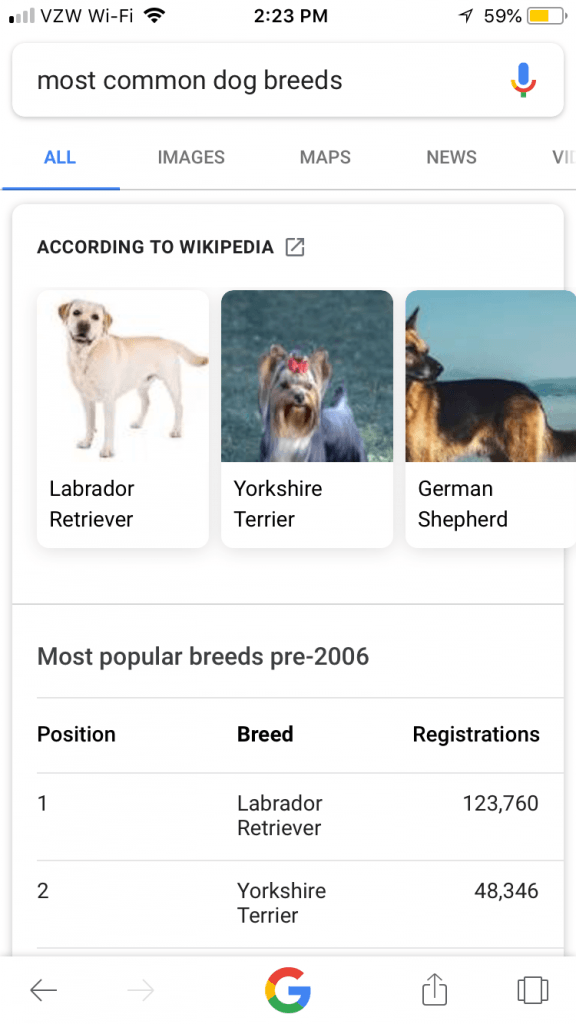
You’ll still get regular search results when you do a voice search, but if Google reads you the featured result and it satisfies your query, you won’t bother with the lower results.
That’s what it means to win the voice search game, in a nutshell.
So how do you optimize your SEO and content for voice search?
#1: How to Find Voice Search Keywords
Voice search keywords are different from the normal search terms you might look for.
The normal keyword length is getting longer, and voice search keywords are naturally long due to the way we speak.
The keywords you should prioritize targeting are natural language keywords.
These natural language keywords are longer search terms that may be around 5 words, or longer. They’re usually questions.
For example, you might type “natural language keywords definition,” but you’d say “what are natural language keywords?”
Even question keywords might be different for voice. You might type “how to do link building,” while a voice search could be “How do I build more links to my website?”
You can find these keywords in any keyword research tool. Google even shows them to you as suggested searches when you type in their search box:
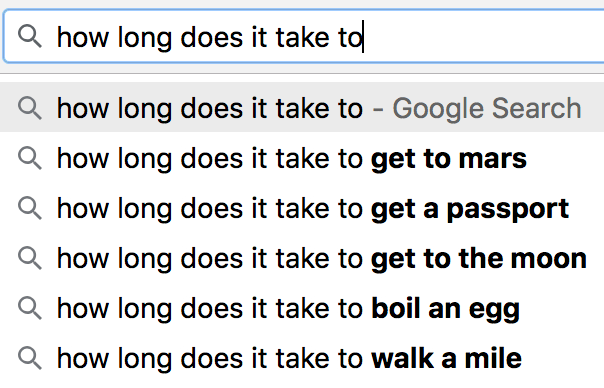
You can use third-party tools like AnswerThePublic.com or Ubersuggest to mine for question keywords that people are actually saying.
Here’s an example of how AnswerThePublic displays questions after you enter a keyword (“online marketing” in this case):

You can also sort AnswerThePublic’s questions into a “Data” view to make them easier to read as a list:

In Ubersuggest, you can filter the list of suggested keywords by ones that contain “question words” like what, how, when, etc.:
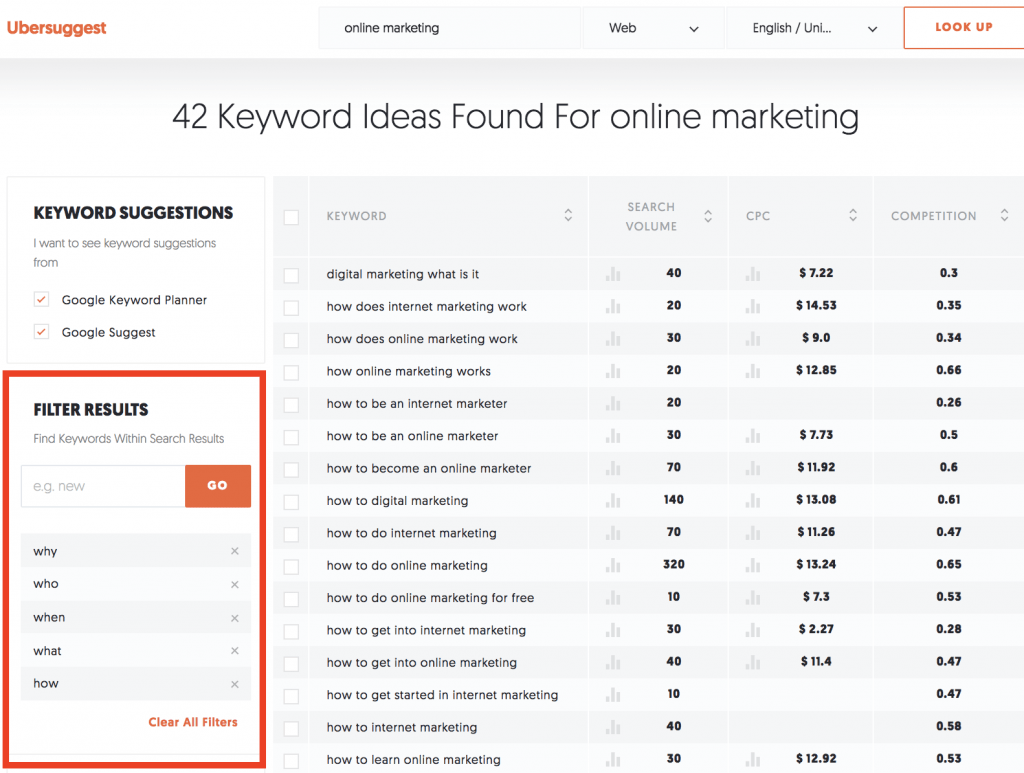
For another approach, I recommend you try mining call center, live chat, and email data to find the commonly asked questions surrounding your company, product or service.
What do you do with these crazy long keywords? Optimize your on-page SEO by sprinkling them in your content.
By including them, you increase the odds that Google will find and use those keywords for a featured result.
Let’s get into how to include them.
#2: How to Optimize Content for Voice Search
Once you’ve found your voice search keywords, you can start optimizing your content around them.
The other advantage is that by optimizing for voice search, you’re structuring your content a lot better in terms of what Google likes to see.
Here’s how to do it:
1.Picking a Topic
Build content that answers commonly asked questions around your brand, services, products, etc..
This includes content that answers “who, what, when, where, why and how” questions. Picking topics this way makes it easy to include all of those voice keywords you found.
Your focus for voice optimization centers around embedding those keywords into your content. Don’t try to optimize your page itself to the voice terms, because less than 2% of voice results had exact KW in their title tag.
Optimize your pages as you normally would, and include as many queries that sound like voice terms on them.
2. Structuring Answers
Embed long tail keywords into your content as answers to the questions being asked.
A general guideline for the answers you provide is to keep them at 30 words at less.
Brian Dean did a study of voice search queries and found that Google tends to answer voice search in short, 29-word results on average.
Shorter/Longer answers are provided by Google as well though. For example, the current answer to:
- “What is the longest season?” is 30 words
- “Do bee stings hurt?” is 50 words
- “How long do cats live?” Is 6 words
So statistically, you can increase the odds of your answer being used by keeping it at around 30 words.
However, it’s worth testing your questions in Google to see what length a competing result’s answer is and aiming for that length yourself.
3.Optimize Long Form Content for Voice
When creating long-form content, embed as many answers as you can into it.
Longer pages with more long tail keywords on them might have a better chance to rank.
Why? Longer content simply plays the numbers game of having more keywords on the page.
Just work them naturally into your writing, don’t make it seem “stuffed” with awkward sounding phrases.
Depending on the keyword, you can also include them as headings and subheadings in your content.
You can learn more about the types of long form content that tend to attract links here.
4.Optimize Short Form Content for Voice
You can also make shorter content that is highly targeted toward voice search keywords. Try the technique of making voice search-based FAQ pages.
Structure the content as a series of question keywords and include more non-question long tail keywords in the answers.
For example, our article about Domain Authority uses this type of FAQ format to answer the question keywords we found about this topic:
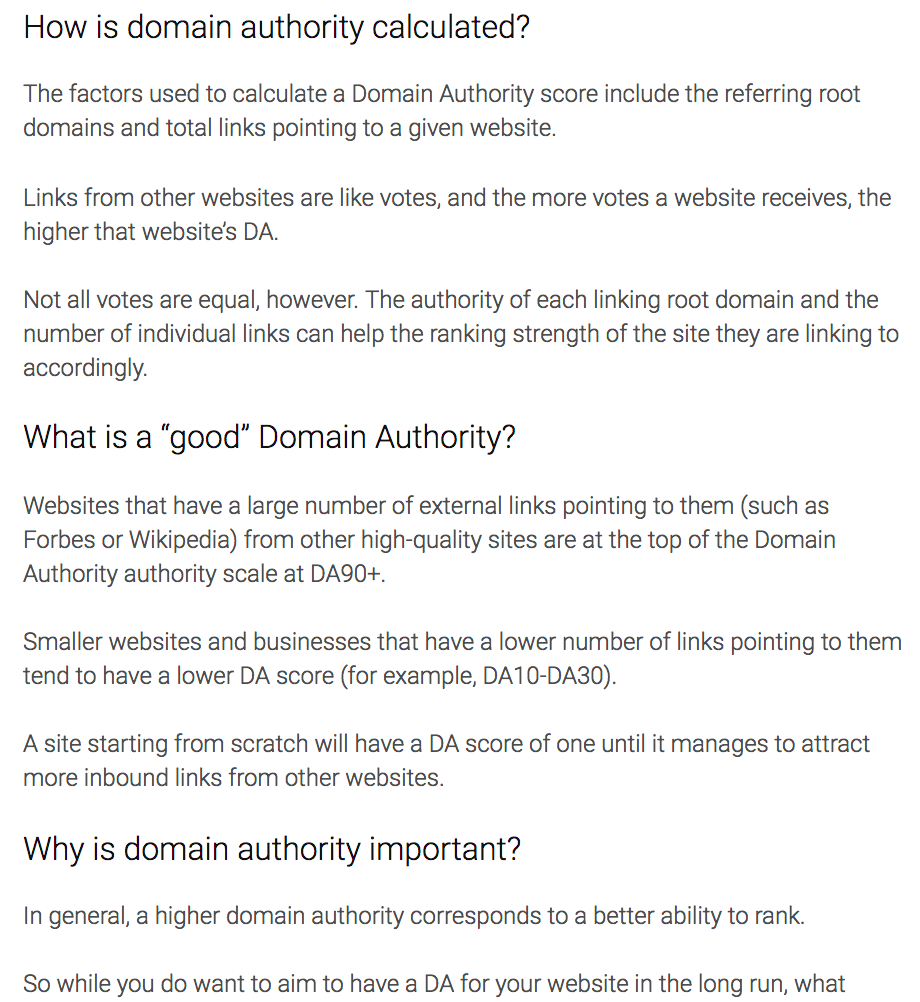
Question KW’s are on the rise and Google wants to give users 30-ish word answers. FAQ pages let you check both boxes.
5.Optimize for Featured Snippets
According to Brian Dean’s study, 40.7% of voice search results came from a featured snippet.
That means by optimizing for featured snippets, you can really improve the odds of your content landing in voice search.
So how do you optimize for featured snippets? Leverage structured data by using schema markup depending on the content type.
For example, if you’re answering “how to change a flat tire” you would use “HowToSection” markup in your page’s code to help Google crawl through the content and recognize the data:

In addition to using schema markup, ensure content is structured well by using headers and bulleted or numbered lists.
This makes it easier for Google to recognize and pull out relevant answers to queries from your content.
6.Write Content with Natural Language
As mentioned already, voice searches tend to sound more natural and less robotic than keyboard-inputted search queries.
Write your content the same way.
For example, if you find a question keyword like “How to tell if a peach is ripe?” Create an in-content “match” for Google to find.
In this featured example, the text Google found was: “You can tell if a peach is ripe or not by a gentle, yet firm squeeze.”

The bottom line here for optimizing your content is: Embed lots of long tail keywords, including question keywords, in it. This can help a single page to rank for lots of different voice search queries.
#3 Voice Search Tips for Local SEO
The possibilities for capturing local customers with voice search optimization are exciting.
Look at how the information provided on The HOTH’s website and on our Google My Business profile appears for different queries:
“What is the HOTH” brings up a miniature version of our Google My Business profile in Google’s Assistant app:
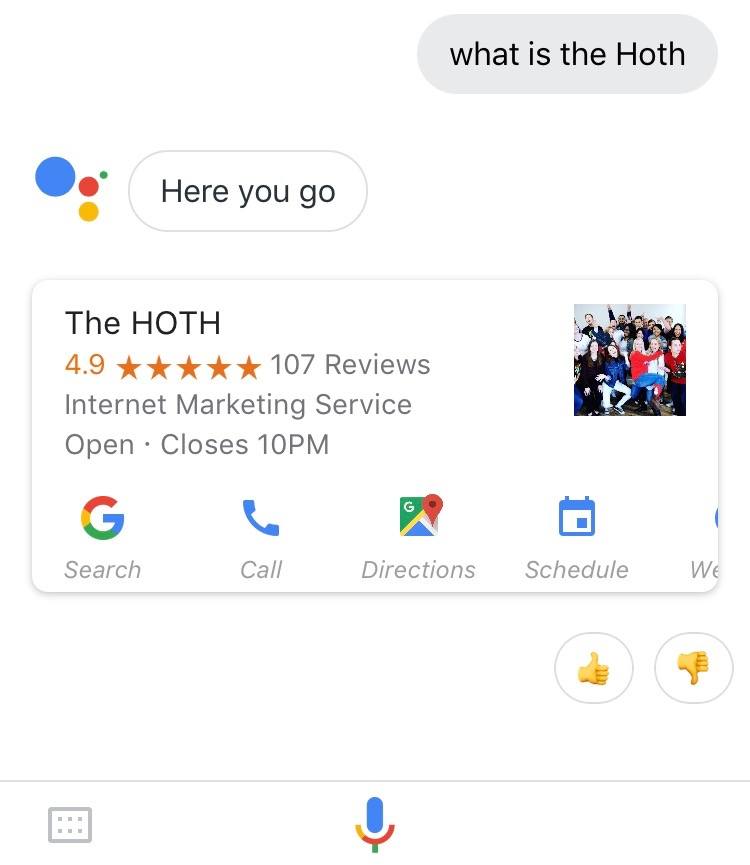
“Directions to The HOTH” uses my location to provide the route:
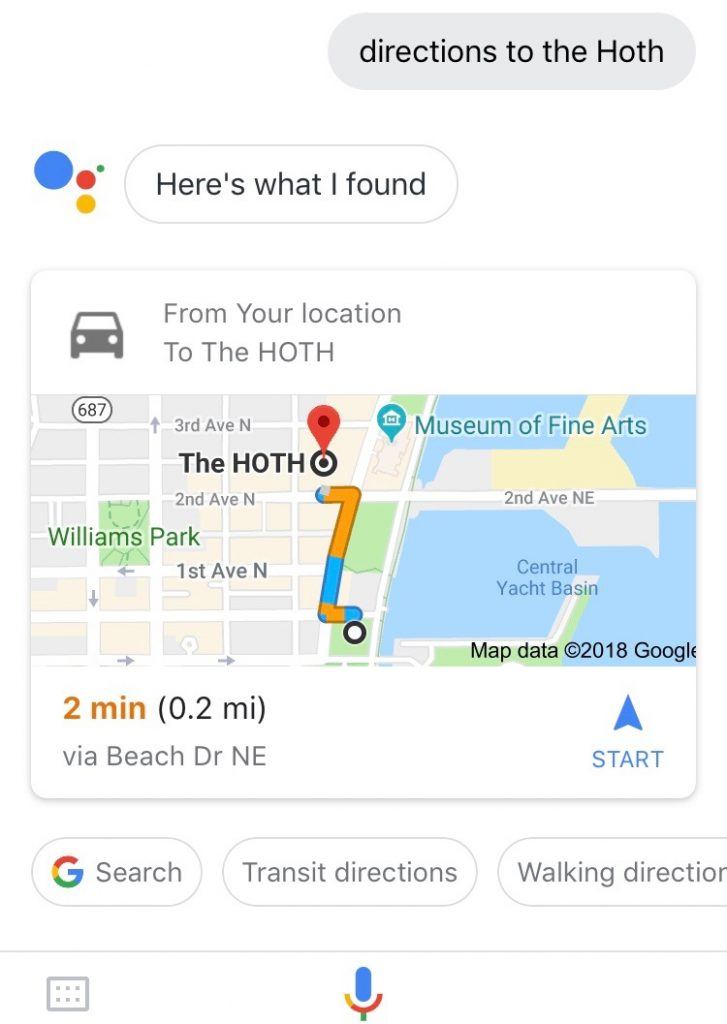
“What does the HOTH sell” crawled one of our articles to provide the answer:
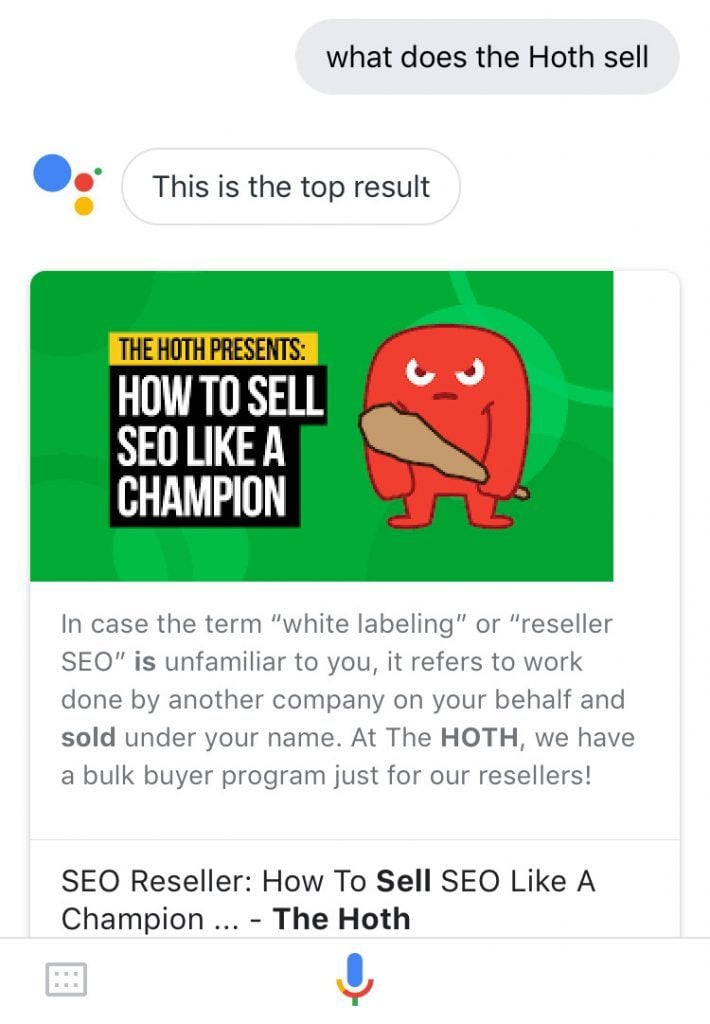
There are a couple more things to keep in mind for local search and voice:
People tend to search for a local business by saying either:
- “Hair salon in Tampa” — In this case Google relies on site content to generate results
- “Hair salon near me” — With “___ near me” searches, Google shows the nearest relevant Google My Business listings in the results
This is why it’s important to not only optimize your website’s content to these queries, but to also claim and optimize your Google My Business profile.
Your GMB listing also helps to ensure that the correct name, address, and phone number (NAP) for your business is accurate when it shows up as a result.
Additionally, it’s important to use GMB’s feature of choosing the category of what your business is.
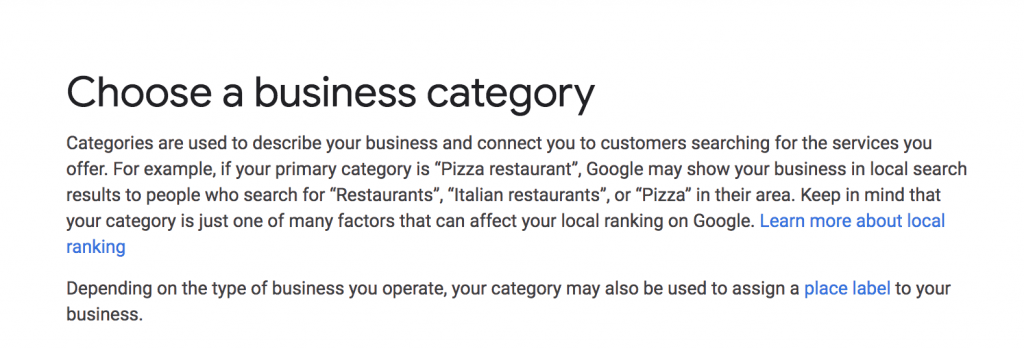
You can see how this is important for voice search: When you “tag” your GMB profile as a hair salon, it’s that much more likely to appear as a result when someone searches for a “hair salon near me.”
#4: More Tips and Strategies for Voice Search Optimization
There are a few other things to keep in mind that can improve the number of times you appear as a result.
1. Work to get your brand in the Knowledge Graph
The more data Google has about you, your site and your target audience, the better your chances will be to appear on the Knowledge Graph panel.
Using structured markup in your content helps with this, as mentioned above.
You can also fill out social media profiles and associate them with your brand to provide even stronger signals to Google.
If you can, get a Wikipedia page. Wikipedia results often appear for voice queries seeking general knowledge.
2. Aim for a 9th grade reading level (or below)
Clear writing is a good guideline in general.
Brian Dean’s study found that content written at a 9th grade reading level or below tends to appear more often as a voice result.
The Flesch-Kincaid Grade Level tells you what grade your content is at. For example, a score of 9.2 would be a 9th grade reading level.
You can test the reading level of your content by using a tool like readable.io that lets you paste text in to see its grade score.
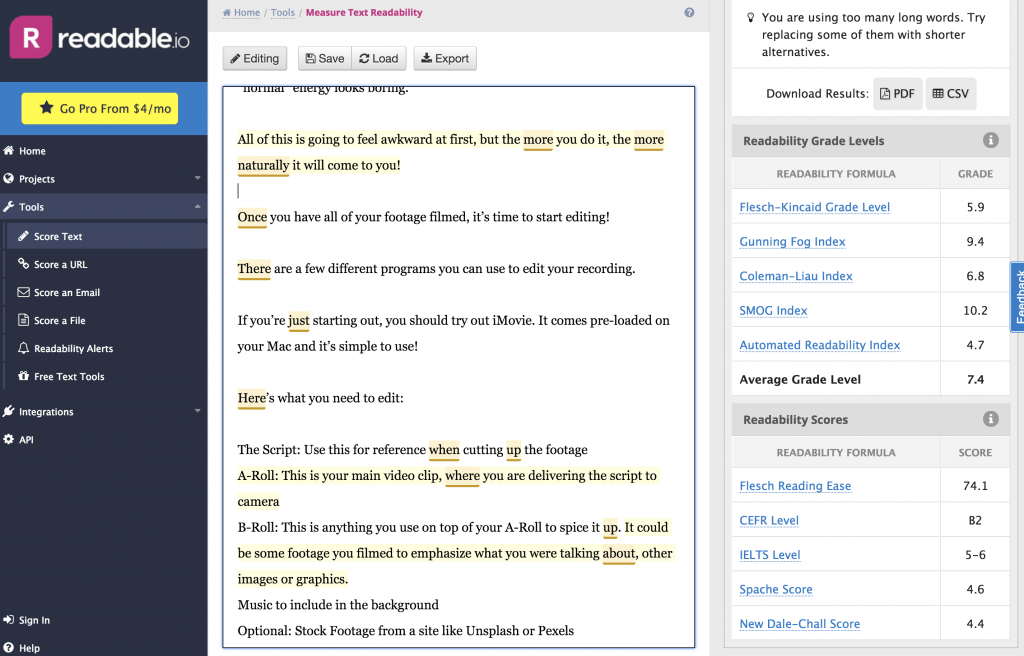
3. Increase Domain Authority
Sites with lots of links pointing to them tend to rank more often in regular search.
You would expect it to be the same for voice, and it is. Brian Dean’s study (and our own tests) found that sites with lots of links indeed rank more often in voice search.
The average Ahrefs Domain Rating of a voice result in Brian’s study of 10,000 Google Home search results was nearly 77.
Page Authority, on the other hand, is not as important for voice search as Domain Authority.
Domain Rating (DR) and URL Rating (UR) are Ahrefs’ equivalent of Moz’ Domain Authority and Page Authority.
Here’s an example of a featured snippet from a page with a low UR (13), but on a site with a good DR (63):

The good DR of this site is what landed this page in the snippet:

Google wants to provide results from authority sites. Build up your domain authority so that Google uses your site.
4. Rank videos in search results
Video seems to be a big part of Google’s strategy for answering voice queries. They tend to show up more for natural language keywords.
To show you what I mean: when I do a standard search for “pineapple cut,” Google knows that I want to know how to cut a pineapple.
They put the videos as the 3rd featured result after the text snippet and the related questions people also ask:
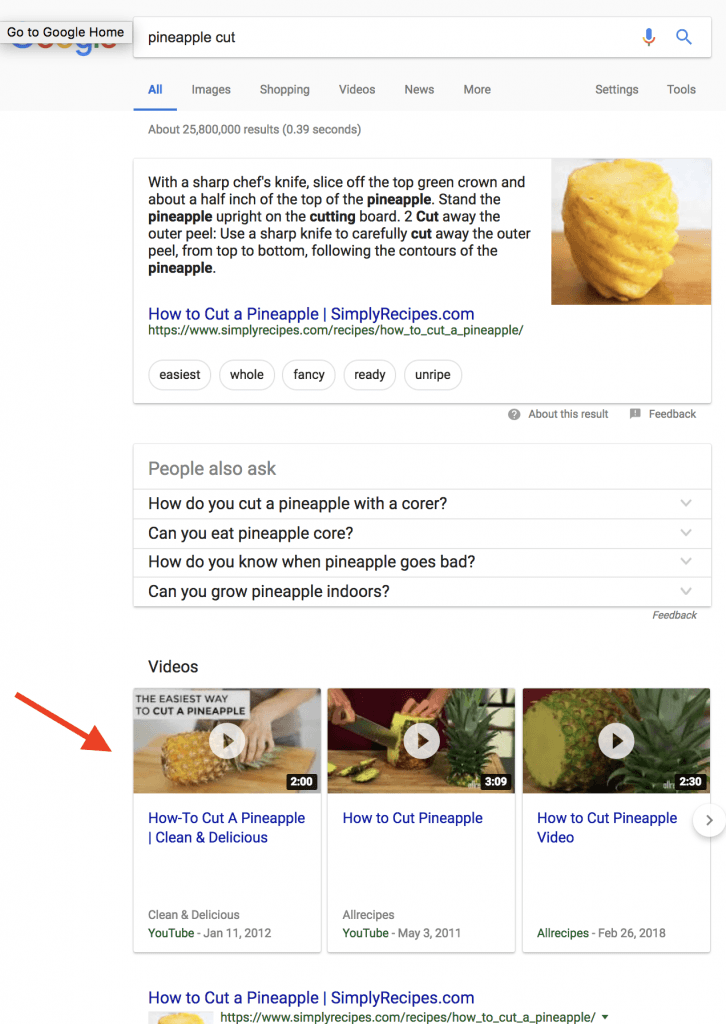
When I use a natural language keyword (“how do I cut a pineapple”) I get the video snippet at the top. Snippets like this one even automatically start at the relevant part of the video that answers my specific query:
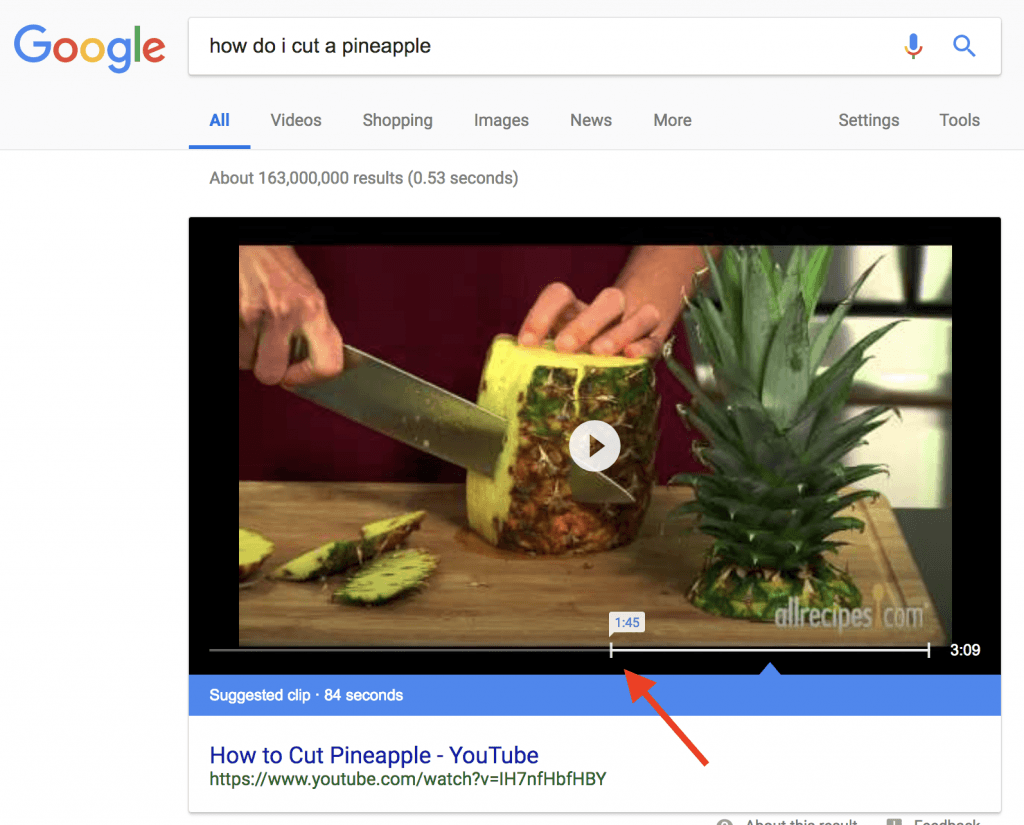
Google will sometimes show text from the video’s description box rather than the video itself in the snippet:
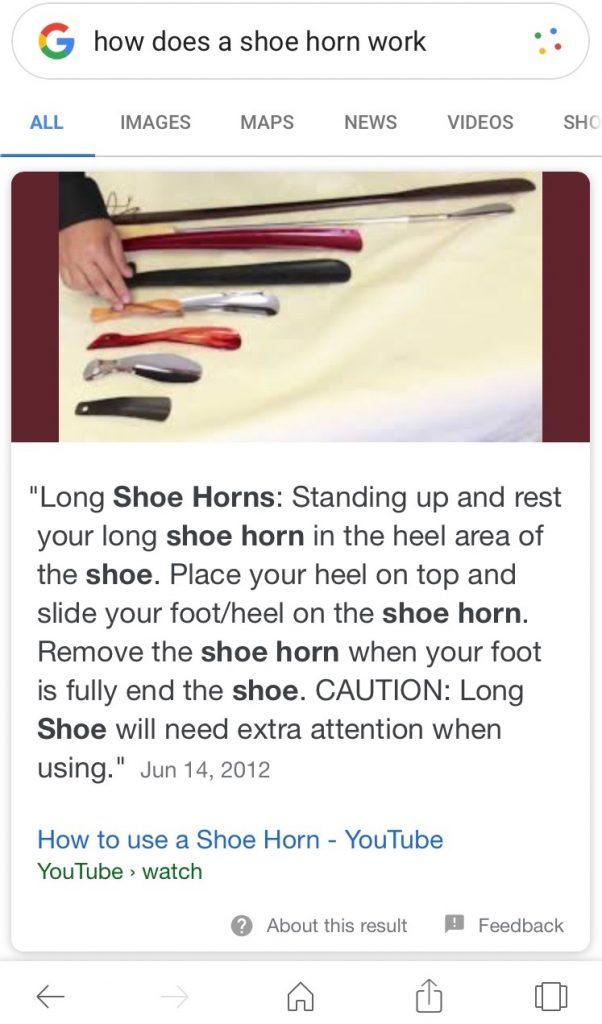
Modifying the search slightly to “how do I use a shoehorn” results in the same top result, this time with the clip rather than text:
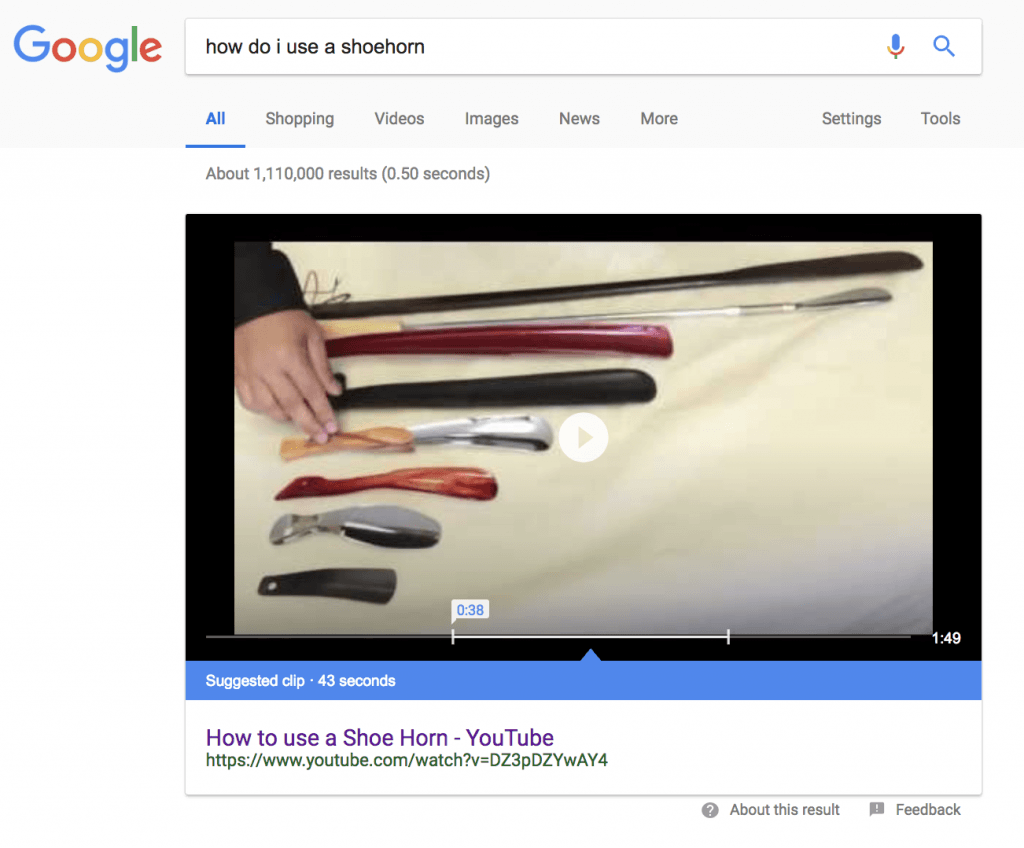
Try to rank your videos by optimizing them for SEO. This includes optimizing your titles and writing detailed video descriptions that use those long tail / natural language voice search keywords.
5. Make Sure Your Site Loads Fast
Google announced in July 2018 that their Speed Update was rolling out for all users.
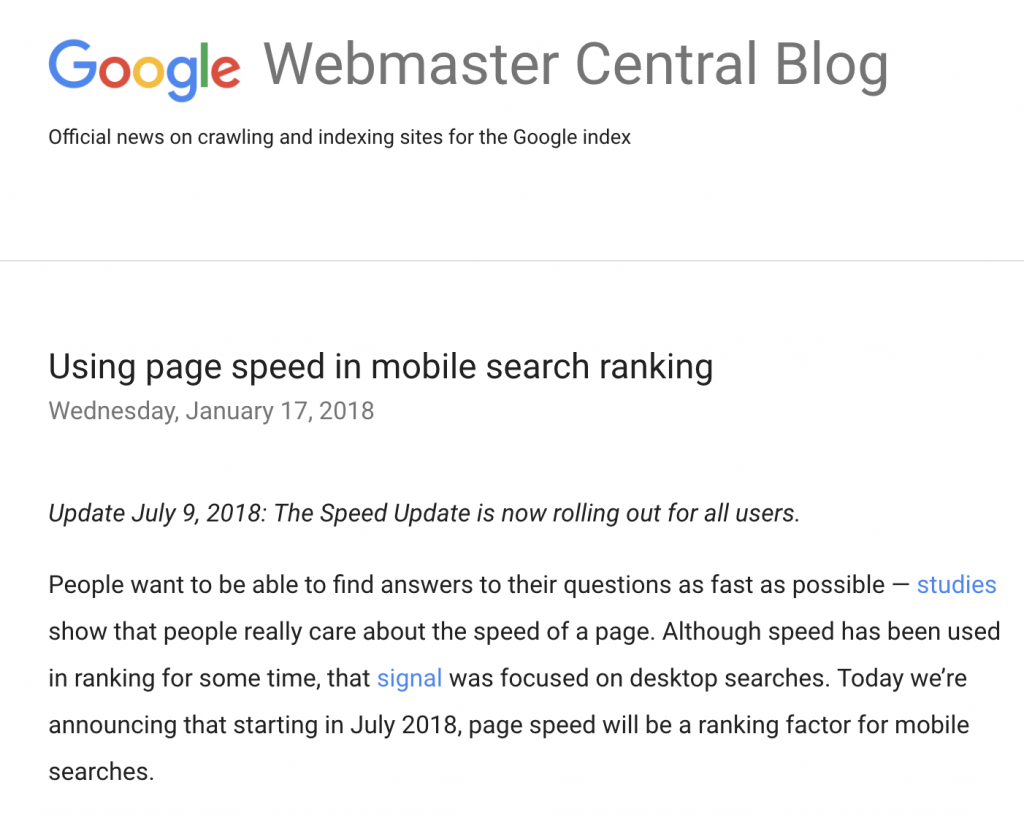
Now that page speed is a ranking factor for mobile searches, you should absolutely improve this factor for your own site.
The average voice search result page loaded in about half the time (4.6 seconds) of the average page. Site speed is definitely important to capture the featured snippet spot.
6. Make Sure Your Site is Mobile Friendly
Mobile friendliness is a huge factor for ranking your site now that Google has released their Mobile First Indexing.
Since people tend to do voice searches on mobile phones more than other devices, your chances to land in the featured snippet goes way down without a mobile-friendly website.
Google has a Mobile Friendliness Test that you can use to see whether you need to optimize for mobile.

Conclusion
Now you have a foundation to optimize your website for voice search SEO.
It’s important to note that voice optimization isn’t separate from regular SEO.
Voice SEO is really the new standard for best optimization practices in general, because:
- Voice search is already a huge trend and it’s only getting more important
- The same things you do to optimize for voice will also help your SEO in general
Now that you’re up to speed on voice search, ask us your questions that came up while reading this in the comments! If you have any tips to add, leave those below as well.

-
Want to reference this guide at a later time?
Let us send you the downloadable version so you can read it whenever.